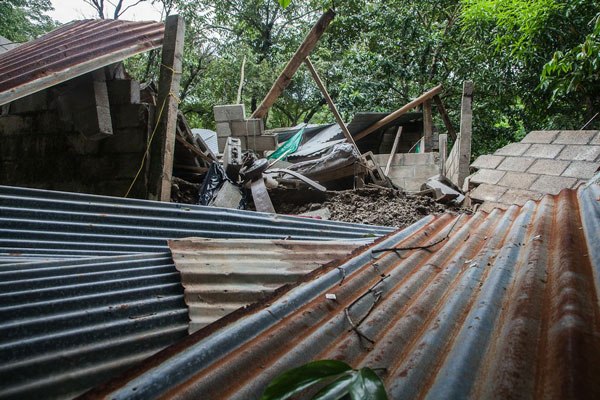
Every day, Flor Coto looks out the window of the house that she and her family rent. Through the window, she sees the land that will house 191 social welfare houses in a few months. One is for her and two are for her daughters.
“I already told the girls, if they come right now and tell me ‘here are the keys to the house,’ I’ll pack and leave right away. It’s a dream for someone to have a house and stop moving around,” said Coto, who lives with her husband, three daughters and four grandchildren.
The lot is located in Bagaces, where the construction company Park Slope Development is developing the Las Palmas project, financed by housing grants from the Housing Mortgage Bank (Banhvi).
“Here in the community, there are many unemployed people and when the project started, they had the opportunity to work there as construction assistants,” Coto said.
Just during 2019, Banhvi built 496,244 square meters (5,341,526 square feet) of social housing financed through the National Housing Financial System.
The “Economic Contribution of the Construction Industry and the Impact of Excess Paperwork” report, published by the Costa Rican Chamber of Construction (CCC), estimates that each square meter of construction contributes 0.08 direct and indirect jobs.
Taking into account that each social housing unit has an average of 42 m² (452 square feet), Banhvi calculates that in 2019, the grants generated approximately 39,700 jobs.
Housing grants don’t just generate employment; they also contribute to community development, according to the vice president of the FinanVivienda association, Jose Umaña.
“Construction in general, and social housing in particular, contribute to generating direct and indirect employment and contribute not just to the national economy, but also to the economy of the communities,” Umaña commented.
This is based on data just for the subsidies destined for building on people’s own lots and for buying a lot and building. Banhvi’s other financing modalities, such as buying and repairing existing homes, aren’t included.
The Economic Chain Behind Each House
“The grants are a solution for the country. It isn’t just a family that is going to have their own house who didn’t before, but also an economic chain set off by the housing projects that generates a lot of employment,” commented Banhvi’s spokesperson, Marianela Morales.
The CCC report agrees that the construction industry is one of the economic activities that most affects the production of other industries.
Developments by the Somabacu construction company in Talamanca are an example of the chain that the CCC and Morales are referring to. Currently the company is working on two projects in the canton that provide a total of 113 housing solutions.
In order to build each of these houses, the company has to hire the boatmen who carry wood along the Telire River, the trucks that transport the materials, the tractors that load the wood on the boats and the warehouses where they store the materials, among other related services.
“The projects can last from three to six months, depending on the number of houses, and generate a lot of work in the community. It’s a very dynamic economy that comes as a result of a social benefit, ”commented Somabacu’s purchasing manager, Pablo Hidalgo.
In addition, the Bribri Talamanca Development Association (ADITIBRI) buys the wood used from people who live in the communities to provide material to the construction company, according to association member Yonoris Espinez.
“By working in this way [as providers,] we see that it’s not just the families who have their own home who benefit, but the community,” she commented.

Edgar Baldodano found work on the Las Palmas project after facing job cuts caused by COVID-19.
The chain generated by construction doens’t just happyen during the building phase. “We must also take into account the employment generated in the previous or subsequent phases,” said the president of the CCC, Esteban Acon.
“Before construction, there are ground studies, consultations… and once a housing development is made, a need arises for there to be a nearby convenience store, development centers, businesses, and all that generates employment,” Acon said.
An Instrument to Reactivate the Economy
The productivity of the construction industry is a reflection of the country’s economy. Its dynamism drops before and during a crisis, but it’s one of the first to recover when the economy reactivates, according to the CCC report.
This became clear to the country after the impact of the COVID-19 pandemic. The National Institute of Statistics and Censuses (INEC) pointed out a reduction of 1,346,567 m² (14,494,327 square feet) in construction between 2019 and 2020, while the CCC estimates that this year, more than 40,000 construction jobs were lost.
This is why Banhvi initiatives are now more relevant than ever. Acon, president of the CCC, believes they are an important support for construction and also create stability in construction employment.
Despite the crisis, from 2019 to October 2020, Banhvi approved 36 projects that provide 512 housing solutions, and 29 more are in the process of being approved.
“There is always a housing project being developed. They are a fixed machine that has been in place for more than 30 years… And where there is a project, there is economic reactivation,” Morales explained.
Umaña from FinanVivienda agrees with the Banhvi spokesperson.
“Aside from helping to solve people’s housing problems, housing grants are an investment, not an expense, of public resources that contributes significantly to reactivation,” said Umaña.







Comments